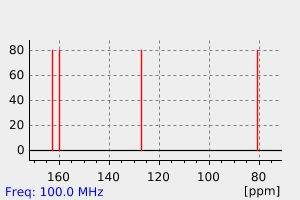2,3-difluoro-4,4-(pentane-1,5-diyl)but-2-en-4-olide | 286372-89-2
中文名称
——
中文别名
——
英文名称
2,3-difluoro-4,4-(pentane-1,5-diyl)but-2-en-4-olide
英文别名
2,3-difluoro-4,4-(pentane-1,5-diyl)-2-buten-4-olide;Dvtzgfimhaeysp-uhfffaoysa-;3,4-difluoro-1-oxaspiro[4.5]dec-3-en-2-one
CAS
286372-89-2
化学式
C9H10F2O2
mdl
——
分子量
188.174
InChiKey
DVTZGFIMHAEYSP-UHFFFAOYSA-N
BEILSTEIN
——
EINECS
——
-
物化性质
-
计算性质
-
ADMET
-
安全信息
-
SDS
-
制备方法与用途
-
上下游信息
-
文献信息
-
表征谱图
-
同类化合物
-
相关功能分类
-
相关结构分类
计算性质
-
辛醇/水分配系数(LogP):1.9
-
重原子数:13
-
可旋转键数:0
-
环数:2.0
-
sp3杂化的碳原子比例:0.67
-
拓扑面积:26.3
-
氢给体数:0
-
氢受体数:4
反应信息
-
作为反应物:描述:胞嘧啶 、 2,3-difluoro-4,4-(pentane-1,5-diyl)but-2-en-4-olide 在 sodium hydride 作用下, 以 N,N-二甲基甲酰胺 为溶剂, 反应 2.0h, 以81%的产率得到4-Amino-1-(3-fluoro-2-oxo-1-oxa-spiro[4.5]dec-3-en-4-yl)-1H-pyrimidin-2-one参考文献:名称:New fluorinated nucleoside analogues with 2-butenolide rings prepared by nucleophilic vinylic fluorine displacement in 4,4-dialkyl-2,3-difluorobut-2-en-4-olides摘要:DOI:10.1070/mc2001v011n01abeh001377
-
作为产物:描述:参考文献:名称:New fluorinated nucleoside analogues with 2-butenolide rings prepared by nucleophilic vinylic fluorine displacement in 4,4-dialkyl-2,3-difluorobut-2-en-4-olides摘要:DOI:10.1070/mc2001v011n01abeh001377
文献信息
-
Fluorine-Containing Butanolides and Butenolides. Vinylic Fluorine Displacement in 4,4-Dialkyl-2,3-difluoro-2-buten-4-olides and a Novel Rearrangement Induced by Organolithium Addition to a Carbonyl Group作者:Oldřich Paleta、Andrew Pelter、Josef Kebrle、Zdeněk Duda、Jan HajduchDOI:10.1016/s0040-4020(00)00167-8日期:2000.53-substituted derivatives (4–24). Softer Grignard reagents in the form of a copper (I) bromide-dimethyl sulfide complex reacted in the same way as O-nucleophiles to afford 3-alkyl- or 3-aryl derivatives (25–26). Harder organolithium reagents attacked the carbonyl group to give unstable hydroxy compounds that rearranged spontaneously to furan(2H)-3-ones (27–29) in a novel oxygen rearrangement reaction.
表征谱图
-
氢谱1HNMR
-
质谱MS
-
碳谱13CNMR
-
红外IR
-
拉曼Raman
-
峰位数据
-
峰位匹配
-
表征信息
同类化合物
(2R)-4-十六烷酰基-3-羟基-2-(羟甲基)-2H-呋喃-5-酮
马来酸酐-丙烯酸共聚物钠盐
马来酸酐-d2
马来酸酐-13C4
马来酸酐-1-13C
马来酸酐
顺丁烯酸酐-2,3-13C2
顺丁烯二酐与2,2-二甲基-1,3-丙二醇和1,2-丙二醇的聚合物
雄甾-3,5,9(11)-三烯-17-酮,3-甲氧基-(8CI,9CI)
阿西弗兰
阻垢分散剂
钾抗坏血酸盐
重氮基烯,二环[2.2.1]庚-1-基(1,1-二甲基乙基)-,(Z)-(9CI)
赤藻糖酸钠
螺甲螨酯代谢物 M01
葫芦巴内酯
葡糖型抗坏血酸
苯基顺酐
聚氧乙烯(2-甲基-2-丙烯基)甲基二醚-马来酸酐共聚物
聚乙烯马来酸酐共聚物
聚(甲基乙烯基醚-ALT-马来酸酐)
聚(异丁烯-马来酸酐)
聚(乙烯-co-丙烯酸乙酯-co-顺丁烯二酐)
聚(乙烯-co-丙烯酸丁酯-co-马来酸酐)
维生素C钠
维生素C磷酸酯钠
维生素C磷酸酯
维生素C杂质
维生素C亚铁盐
维生素C乙基醚
维生素 C 磷酸酯镁
维生素 C
维他命C磷酸镁盐
维他命C杂质
纯绿青霉酸
粘氯酸酐
粘氯酸酐
粘氯酸酐
粘康酸内酯
粉青霉酸酐
穿心莲丁素
硫酰胺,(3-氰基-5,6,7,8-四氢-4H-环庚三烯并[b]噻吩并-2-基)-(9CI)
白头翁素
甲基[(2S,3R)-2-乙氧基-3,6-二氢-2H-吡喃-3-基]乙酸酯
甲基7-氧杂双环[2.2.1]庚-2,5-二烯-2-羧酸酯
甲基5-甲基-4,5-二氢-3-呋喃羧酸酯
甲基4-氰基-2,5-二氢-3-呋喃羧酸酯
甲基4-氧代四氢-2-呋喃羧酸酯
甲基4,5-二氢-2-呋喃羧酸酯
甲基3-甲基-2,3-二氢-3-呋喃羧酸酯







